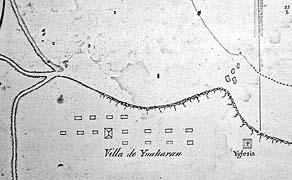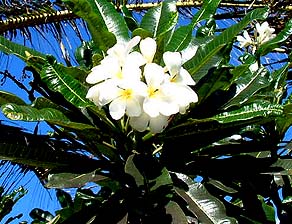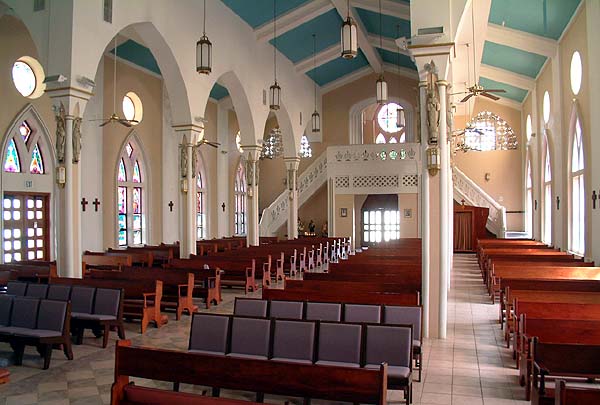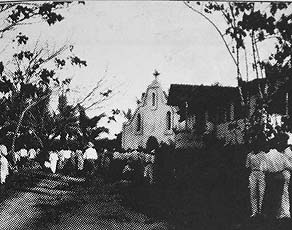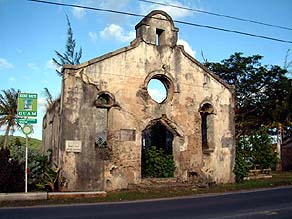 |
 |
 |
 |
||||
|
|
|
|
|
|
|
|
|
|
|
|||||||
|
|
|
|
St. Joseph's Church in Inarajan.
|
|
|
When Inarajan was established by the Spanish in 1680, the village was designed in the Spanish style with a church as its focus. “They had a goal that everybody had to live within sound of the church bells,” Larry says. And the map made by the Duperrey expedition in the early 1700s shows the prominence of the church in Inarajan village. That church has long since been replaced several times, but it remains the home of St. Joseph, whose arrival here is a well known story in Inarajan.
|
||
|
|
||
|
“Our patron saint is San Jose or St. Joseph," Bill recalls. "We have the original statute up to this day here within the church. How did that happen? The Spaniards at that time were actually trying to bring the statue in to Umatac. I could see the connection because some people of Inarajan were relocated from Fu‘una, a village near Umatac that was established before the occupation of the Spaniards. But then wanting that control the Spaniards moved the people to Inarajan and they simply abandoned Fu‘una as a lost village. "And so I could see somehow the correlation, why the ship that was bringing that statue was going down to Umatac. But somehow because there was a storm, there was no way that the ship could get in to Umatac. Then that ship tried to get into Merizo, and finally somehow the ship was able to get into the bay at Inarajan."
|
|
|
Plumeria.
|
“The native peoples didn’t really understand what was going on. Then they saw that the Spanish were trying to unload the statue, because it’s a pretty big statue. And there is a certain plumeria that we had here on Guam that, from my recollection as a child, grows only in Inarajan. Somehow the natives took this plumeria, and as the statue was actually coming in, they were giving the flowers as a welcome to the statue of St. Joseph. And so it was brought over."
|
|
|
|
|
|
|
“St. Joseph is not just a patron saint of the families but is also the husband of Mary," Bill elaborates. "He’s a patron for people that are married. And so I believe that through that kind of spirituality, people were just amazed how all these typhoons and the earthquakes, and yet not one stood up even with the bombing during World War II. It was hit by a bomb and it went through. On one side of the facade, there was a big hole where it actually hit, through the bombing, and it just went all the way back to the sacristy, and it went through."
|
||
|
|
||
|
“The current Catholic church was built in 1939 and is still standing,” Bill tells us. “The construction really was finished in 1939, but then the church was condemned by the military after the War. Bishop Baumgartner said it was unsafe, but Father Bernabe was the priest who got started to rehabilitate the church. "I believe that the persistence of the council members or the committee that the priests organized at that time, through that kind of persistence or perseverance, they managed to get the church back in shape. I remember Father Camacho, who is now the Bishop of Saipan, was the pastor there, and he worked on that rehabilitation of the church."
|
|
|
|
"But then came with those series of Typhoons—Yuri, Typhoon Russ and Typhoon Omar—and then the big earthquake in 1993. We were celebrating my daughter’s birthday that evening, and at that time it was shaking, you know it looks like the whole world was ready to collapse. The steeple just broke, I don’t know how many feet but it just landed and it stood right into the ground, standing up, upside down. The cross, it turned upside down. "That was a very serious devastation for the church, and then the walls were also cracked and you could see almost the entire sky from that, but I guess again we were very persistent. I was a Council member, the treasurer. We managed to raise almost a half million dollars for our matching fund with Guam Preservation Trust. We got some money and that’s how we brought that church to the way it is right now." |
|
"We rehabilitated the church in Inarajan, in I believe 1996 or 1997 because it was damaged by the earthquake here in August 8th of 1993. When finally it was turned over to the contractor to do the rehabilitation, they found out that there were no footings or foundations to hold it. "But can you imagine all the earthquakes and plus the typhoons? It stood up. It stood up, you know what, I think it was the grace of God that made it stand, and also the devotion of the people there with the saints."
|
|
|
|
|
|
Closely connected with the church, though a bit further down the road, is the cemetery.
|
||
|
|
||
|
|
|
|
|
|

|
| Inarajan Home | Map Library | Site Map | Pacific Worlds Home |
|
|
|
|
|
|
|
|||
| Copyright 2003 Pacific Worlds & Associates • Usage Policy • Webmaster |
|||

